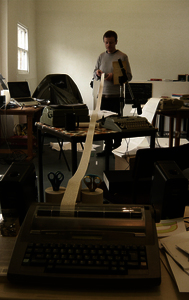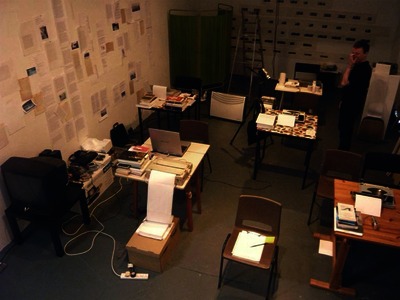Chapman, Neil  ORCID: https://orcid.org/0000-0001-8253-0256 and Stent, David
(2021)
Writing as Occupation: thickening of thought and narrative loops, even.
In:
History(s) of MEANTIME.
School of Arts, University of Gloucestershire, Cheltenham, pp. 26-32.
ISBN ISBN 978-1-914900-01-3
ORCID: https://orcid.org/0000-0001-8253-0256 and Stent, David
(2021)
Writing as Occupation: thickening of thought and narrative loops, even.
In:
History(s) of MEANTIME.
School of Arts, University of Gloucestershire, Cheltenham, pp. 26-32.
ISBN ISBN 978-1-914900-01-3
Preview |
Text (Collaboratively produced book chapter)
Thickening_of_thought.pdf Available under License Creative Commons Attribution No Derivatives. Download (6MB) | Preview |
![[thumbnail of 848a copy.jpg]](https://repository.falmouth.ac.uk/4438/6.hassmallThumbnailVersion/848a%20copy.jpg)  Preview |
Image
848a copy.jpg Download (963kB) | Preview |
![[thumbnail of 881 copy.jpg]](https://repository.falmouth.ac.uk/4438/7.hassmallThumbnailVersion/881%20copy.jpg)  Preview |
Image
881 copy.jpg Download (90kB) | Preview |
Preview |
Text
WRITING AS OCCUPATION WEB TEXT.pdf Download (300kB) | Preview |
Abstract / Summary
This text is one manifestation of an ongoing research project exploring questions around writing as a practice in art and art research. Writing as Occupation was inaugurated in 2013 by David Stent (West Dean College) and Neil Chapman as a series of residencies looking at twin implications in the term ‘occupation’: on the one hand, writing as a form of work and on the other the sense of space being taken up or taken over by writing. In Writing as Occupation the residency venues are organised with ‘stations’, each equipped with various obsolete typewriter/printer technologies then used to generate writing in a way that foregrounds the material qualities of writing process, implying a certain risk for writing’s so-called ‘content’. Writing as Occupation looks for the potentials of the act when common and dominant expectations of practice are resisted, projecting futures beyond disciplines and beyond the market economy that commoditises work. From the texts generated during the residencies, pieces for publication are drawn. ‘thickening of thought and narrative loops, even’ is one such. Preparing the text for publication has involved careful retention of certain unexpected elements generated through the earlier, exploratory work. The parallel format for instance was first a result of experimentation with typewriter line spacing, coloured ink ribbons and collective working process. The layout implies a divergent reading, exposing reading also as material practice. The reader is led to engage with agrammatical qualities of the writing in ways that open the subject position to new considerations. While (or because) the parallel texts don’t correspond straightforwardly in their content, certain resonances become apparent as immaterial qualities. Insofar as the vitality of materials and material practices rely on immanent immaterialities, this piece contributes to current discourses on materialism, which, although dominant in other disciplines remain relatively under-explored in art.
| Item Type: | Book Section |
|---|---|
| ISBN: | ISBN 978-1-914900-01-3 |
| Subjects: | Creative Art & Design > Illustration & Drawing Creative Art & Design > Fine Art Creative Art & Design History, Geography & Environment |
| Department: | Falmouth School of Art |
| Depositing User: | Neil Chapman |
| Date Deposited: | 11 Nov 2021 12:49 |
| Last Modified: | 15 Nov 2024 15:36 |
| URI: | https://repository.falmouth.ac.uk/id/eprint/4438 |
 |
View Record (staff only) |

 Advanced Search
Advanced Search Tools
Tools Tools
Tools